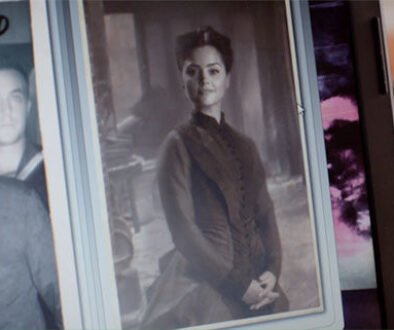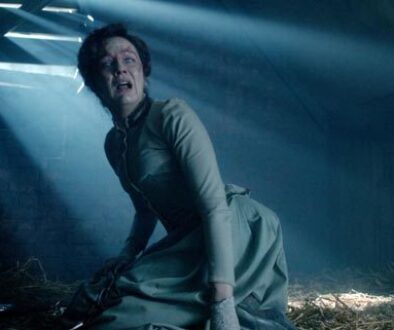The Crimson Horror Review
Clint Hassell reviews Mark Gatiss’ latest episode.

Despite being set in 1893, “The Crimson Horror” seems more closely related to the modern day “Night Terrors” than any of the historical episodes written by Mark Gatiss. The two episodes encapsulate perfectly the greatness of Doctor Who – both the show and the character – with “Night Terrors” focusing on the Doctor’s humanity and “The Crimson Horror” summarizing the charm of the program as a whole. As such, “The Crimson Horror” may be the 50th anniversary special that the show deserves.
As in “Night Terrors” (my review of which can be found here
), Gatiss fills his script for “The Crimson Horror” with references to Who’s history. Before saying it to Clara, the Doctor often said “Brave heart!” to former-companion Tegan Jovanka, the “gobby Australian” mentioned during the episode’s flashback. The Doctor’s “John Smith” alias gets a mention, this time with a “Mrs.” attached. Further, the script sums up basically every Doctor Who episode to date with one line of dialogue: “I’m the Doctor, you’re nuts, and I’m going to stop you.” Recently, the number of allusions to the show’s past has skyrocketed, causing Series 7.2 to function as a loving tribute to the 50th anniversary. When Moffat stated, “Why talk in the singular? . . . It won’t just be one thing,” perhaps he was referencing not just to the upcoming 3-D special and Gatiss’ An Adventure in Space and Time, but also to the second half of Series 7?

Just as one would expect for an anniversary celebration, “The Crimson Horror” returns fan-favorite characters to the narrative. Did the episode feature an appearance by Captain Jack? Or Martha? Or Jenny? No, no, and, well, yes – but not that Jenny. However, despite their recent additions to Who, are the Paternoster Gang any less beloved? “The Crimson Horror” effectively uses the trio to examine many of the Doctor’s qualities. Note the exchange between Vastra and Strax:
Vastra: “To find him, [Jenny] needs only ignore all ‘keep out’ signs, go through every locked door, and run towards any form of danger that presents itself.”
Strax: “Business as usual, then.”
Vastra: “Business as usual.”
The quote not only encapsulates the Doctor’s tenacious desire to help others, but serves as evidence that the trio have also taken on the Doctor’s cause – a running theme throughout the show’s history. Note that “The Crimson Horror” pointedly shows what “The Snowmen” only hinted at: the door to the Paternoster Gang’s house is painted TARDIS-blue, its paneling even reminiscent of the phone box’s design.
Jenny, especially, mirrors the Doctor as she gains information regarding Sweetville by befriending Abigail; it is the Doctor’s fascination with people and their experiences that so often benefit him. Jenny’s realization that the disappearance of Abigail’s friend is a sign of trouble is very Doctor-esque, and it is poignant that the moment is followed by Jenny’s unlocking a door – though in a way decidedly less sonic than normal for this show. Convincing Abigail to “faint” surely causes the girl to not be chosen as a Sweetville “pilgrim,” a quick-thinking move on Jenny’s part that not only creates a distraction, but probably saves Abigail’s life – another common Doctor Who occurrence.

Great science fiction utilizes fantastical plot devices to examine universal truths about the human condition. Doctor Who’s use of time travel repeatedly demonstrates that, no matter the time period, human emotions and behaviors remain the same. Here, Gatiss’ script makes great use of its historical setting. Though sensible in the episode’s Yorkshire, 1892 setting, Mrs. Gillyflower’s lecture against “present moral decay” remains topical and relevant to an audience in 2013. Gillyflower speaks of a “coming apocalypse,” an event that continues to spur real-life religious zealots to crazed acts, especially in this past year. By examining a modern-day issue in the context of a historical episode, “The Crimson Horror” becomes a story perfectly suited to Doctor Who. Mrs. Gillyflower, and not the red, squishy Mr. Sweet, or its “crimson horror” effect, is revealed as the true monster of the narrative, allowing the story to play for both children and adults. It is especially impressive is that Mrs. Gillyflower’s “sermon” is appropriately set in a church and even contains a hymn – a bold statement against the more radical aspects of organized religion.
Especially impressive is Gatiss’ inclusion of William Blake’s poem, “And did those feet in ancient time,” in Gillyflower’s homily (despite it not being set to music until 1916 – a minor nitpick). The poem, now most familiar as the hymn “Jerusalem,” recounts a fabled visit by a young Jesus to England, where He briefly establishes heaven in England, in contrast to the “dark Satanic mills” of the Industrial Revolution. Both this heaven on Earth, and the title of the hymn, is referenced later by Ada, when she comments that “there will be room for [her and her ‘monster’] in the new Jerusalem.” By utilizing historically-relevant religious rhetoric as motive, Gatiss strengthens both Gillyflower’s character, and his script’s setting.
Further, optography was a widespread belief in the late 19th and early 20th centuries, and was even a frequent plot device in fiction, so its inclusion in “The Crimson Horror” reinforces the episode’s time frame.

Diana Rigg and Rachael Stirling obviously had a lot of fun acting opposite each other. Stirling is a fantastically believable crier, and her Ada is layered with the tragedy of abuse, a “sentimental attachment” to the Doctor, and, finally, earned anger. Mrs. Gillyflower’s blustering, sputtering intolerance is almost overacted, but stays just this side of melodrama. The role would have been wildly overplayed by a lesser actress, but Rigg shrieks her way to greatness, refusing to allow the character any redemption.
“The Crimson Horror” balances the family dynamics of Mrs. Gillyflower and Ada with the humor of the Paternoster Gang. Strax continues to confuse sexes, forms judgments based solely on battle-readiness, and mentions ever-more macabre instruments of destruction (this time, “scissor grenades, limbo vapor, and triple-blast brain splitters”). Seeing a Sontaran adjusting to life outside of his warrior element may take comedic license, but it hasn’t yet worn thin – despite it having been five years since the trio joined forces after the Battle of Demons Run.
Further, the trio contributes effectively to the plot of the story, with Jenny playing the largest role. Her fight scene is an astonishing moment of fan service (if too short), and it’s interesting to see that Jenny has the same effect on the Doctor’s sonic as Mata Hari. The episode is constructed so that the sudden appearances of Vastra and Strax – he in full battle armor, Sontaran rifle blasting – are both surprising and sensible. While Clara’s figuring out that the lack of smoke coming from the chimneys is suspicious seems like another example of the show forcing us to love the Doctor’s new companion – especially since it is Jenny who investigates Sweetville’s inner workings – it is nice when she gets an earned moment of resourcefulness:
the Doctor: “Hang on, hang on. I’ve got a sonic screwdriver.”
Clara: “Yeah? And I’ve got a chair.”

The fact that the episode’s flashback looks like antique film footage is a really nice stylistic touch and shows that the show can dazzle at every level of production, given a creative staff.
Still, “The Crimson Horror” is not without its flaws, however minor. It is terribly convenient that the “crimson horror” formerly plagued the exact ancient time period of this week’s recurring guest star. Matt Smith plays the “preserved” Doctor broadly, and never consistently between scenes, raising questions as to how the Doctor could supposedly feed himself, yet not free himself by reaching the sonic inside his coat’s pocket. Further, if the Doctor was fairly unable to move, then why was his existence not discovered when Mrs. Gillyflower came to retrieve Edmund’s body? And, how did Mrs. Gillflower’s anachronistic rocket not incinerate everyone in the stairwell, as it fired past?
A final question: while having dinner with Ada, we see Mrs. Gillyflower feed the as-yet-unseen Mr. Sweet what appears to be sugar from an overturned bowl. However, she flings a pinch of the substance over her left shoulder “to keep the devil at bay,” a tradition closely associated with salt. So, why did Mrs. Gillyflower refer to the leech as “Mr. Sweet” and not as “Señor Salty”?








